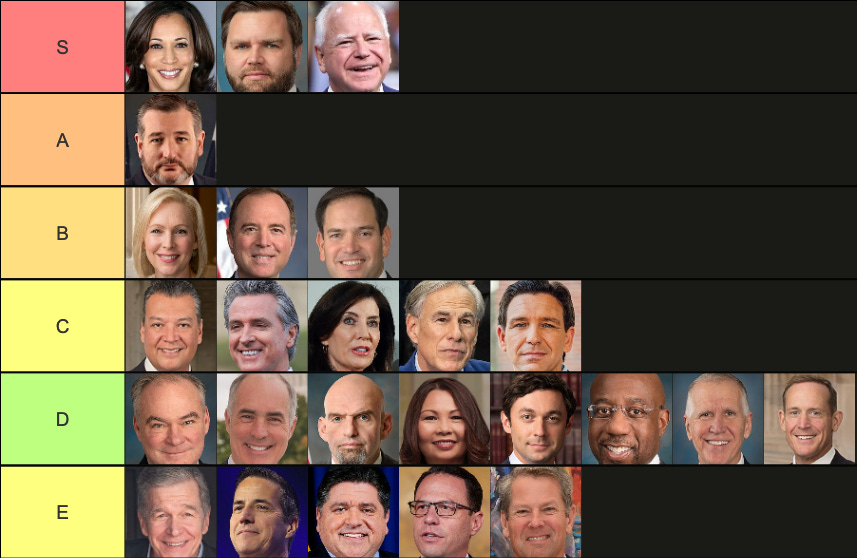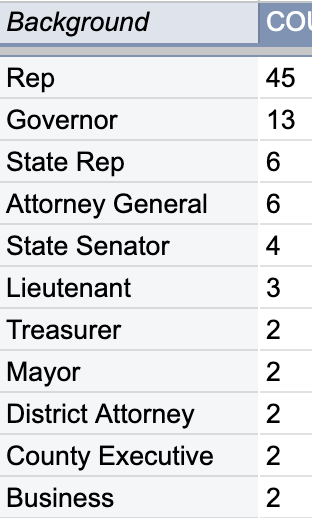Almost Presidents 2 - Senators
Main
This is a sequel to my post about Almost Presidents. We’ll see that senators beat governors, trace the origins a bit, and make new predictions for 2028-36.
Senators are cooler than governors
Why is that and how do we know?
Senator terms are 6 years while Governor terms are 4 years.
14 of the 100 current senators were governor first, but only 3 of 115 governors that I looked up were senator first.
Despite there being twice as many active senators, there are fewer different senators than governors over time.
That means that not only is a senator’s default term 50% longer, their average term is 150% longer! Even some large states like Florida, Virginia, and Colorado send governors to the senate. Now let’s look again at almost presidents.
First, an update in definition - I’ve added the running mates for Democratic and Republican candidates, but removed duplicate runs by the same candidate over multiple years. I’ve restricted the date range to post-WWII, leaving 67 almost presidents.
Among these, 49% were senators, while only 30% were governors. Combined with the rarity of senators over time, this means a senator is about twice as likely to be almost president in their lifetime. Just as a side note, since only 1 person was both (Muskie), this covers a whopping 78% of almost presidents. Throw in US representatives and you reach 87% coverage.
Origin of senators
Surprisingly, while I can find articles about the origins of governors and members of the house, I don’t see one on senators. Let’s make our own!
Senators are much more concentrated in a few backgrounds than governors are. 4 of the 5 most common previous jobs for both senators and governors are US representative, state representative, state attorney general, and state senator. Continuing down, the lists look almost identical except for slight reordering. However, while 45% of senators were representatives before, only 16% of governors were, and that extra 29% is distributed among a wide variety of backgrounds for governors. I think this also shows that being a US representative is the next most desired job after governor.
This all agrees pretty well with the links above and makes me want to dig in to representatives.
Big states
Now that we’ve expanded the definition of president a bit and narrowed our list of candidates, we have a decent shot of picking a winner. I estimate that one in every 23 senators will be almost president. Can we do better? Well, almost presidents also tend to come from big states.
At the top of the list, 3 of the 4 states with the most candidates are also 3 of the 4 largest states. Florida is conspicuously absent, but the next 3 largest states of Pennsylvania, Illinois, and Ohio all make an appearance near the top of the list. I believe restricting our attention to the 9 most populous states (half the US population) will give us about a third of the candidates.
So who’s it gonna be?
I expect to see around 10 distinct almost presidents over the 2028-36 elections, or around 15 counting repeats. Some of them will be the obvious - Trump, Harris, Vance, Walz, or Pence.
Ted Cruz could come back
Ted is young. Ted is already an almost president.
Hell, Tim Kaine could come back. He, Rick Santorum, Paul Ryan and Sarah Palin are all under 70 and almost presidents. However, only Kaine is still in politics. Even Kaine is unlikely because running mates are the weakest almost presidents. If that’s all they have on their resume they tend not to come back in future elections.
Ted Cruz is still active and did well enough to get runner up to Trump in 2016.
Young blood
In many cases we know who’s likely to win this year’s senatorial election. Together with sitting senators we have a few high probability candidates. I’ll skip people who were appointed or are old.
California - Adam Schiff (13%), Gavin Newsom (7%), Alex Padilla (7%)
Texas - Ted Cruz (21%), Greg Abbott (7%)
Florida - Marco Rubio (14%), Ron DeSantis (7%)
New York - Kirsten Gillibrand (13%), Kathy Hochul (7%)
The next 5 states (4.5%) - Bob Casey Jr., John Fetterman, Tammy Duckworth, Jon Ossoff, Raphael Warnock, Thom Tillis, Ted Budd, Tim Kaine
Less likely from those states (2.3%) - Bernie Moreno, Josh Shapiro, J. B. Pritzker, Brian Kemp, Roy Cooper
So with this list of 22 people, I think I’ve identified 1.4 out of the 7 new almost presidents we are likely to see by 2036.




